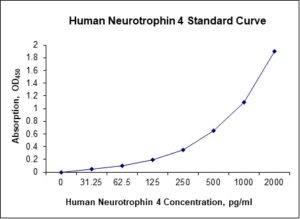Nori Human Neurotrophin 4 ELISA Kit
$461.00 – $832.00
This ELISA kit is for quantification of NT-4 in human. This is a quick ELISA assay that reduces time to 50% compared to the conventional method, and the entire assay only takes 3 hours. This assay employs the quantitative sandwich enzyme immunoassay technique and uses biotin-streptavidin chemistry to improve the performance of the assays. An antibody specific for NT-4 has been pre-coated onto a microplate. Standards and samples are pipetted into the wells and any NT-4 present is bound by the immobilized antibody. After washing away any unbound substances, a detection antibody specific for NT-4 is added to the wells. Following wash to remove any unbound antibody reagent, a detection reagent is added. After intensive wash a substrate solution is added to the wells and color develops in proportion to the amount of NT-4 bound in the initial step. The color development is stopped, and the intensity of the color is measured.
Alternative names for NT-4: Neurotrophin 4, neurotrophin 5 (NT-5), NTF4
This product is for laboratory research use only not for diagnostic and therapeutic purposes or any other purposes.
- Description
- How Elisa Works
- Product Citation ()
- Reviews (0)
Description
Nori Human Neurotrophin 4 ELISA Kit Summary
Alternative names for NT-4: Neurotrophin 4, neurotrophin 5 (NT-5), NTF4
| Assay Type | Solid Phase Sandwich ELISA |
| Format | 96-well Microplate or 96-Well Strip Microplate |
| Method of Detection | Colorimetric |
| Number of Targets Detected | 1 |
| Target Antigen Accession Number | P34130 |
| Assay Length | 3 hours |
| Quantitative/Semiquantitative | Quantitative |
| Sample Type | Plasma, Serum, Cell Culture, Urine, Cell/Tissue Lysates, Synovial Fluid, BAL, |
| Recommended Sample Dilution (Plasma/Serum) | No dilution for sample <ULOQ; sufficient dilution for samples >ULOQ |
| Sensitivity | 6 pg/mL |
| Detection Range | 31.25-2000 pg/mL |
| Specificity | Natural and recombinant human NT-4 |
| Cross-Reactivity | < 0.5% cross-reactivity observed with available related molecules, < 50% cross-species reactivity observed with species tested. |
| Interference | No significant interference observed with available related molecules |
| Storage/Stability | 4 ºC for up to 6 months |
| Usage | For Laboratory Research Use Only. Not for diagnostic or therapeutic use. |
| Additional Notes | The kit allows for use in multiple experiments. |
Standard Curve
Kit Components
1. Pre-coated 96-well Microplate
2. Biotinylated Detection Antibody
3. Streptavidin-HRP Conjugate
4. Lyophilized Standards
5. TMB One-Step Substrate
6. Stop Solution
7. 20 x PBS
8. Assay Buffer
Other Materials Required but not Provided:
1. Microplate Reader capable of measuring absorption at 450 nm
2. Log-log graph paper or computer and software for ELISA data analysis
3. Precision pipettes (1-1000 µl)
4. Multi-channel pipettes (300 µl)
5. Distilled or deionized water
Protocol Outline
1. Prepare all reagents, samples and standards as instructed in the datasheet.
2. Add 100 µl of Standard or samples to each well and incubate 1 h at RT.
3. Add 100 µl of Working Detection Antibody to each well and incubate 1 h at RT.
4. Add 100 µl of Working Streptavidin-HRP to each well and incubate 20 min at RT.
5. Add 100 µl of Substrate to each well and incubate 5-30 min at RT.
6. Add 50 µl of Stop Solution to each well and read at 450 nm immediately.
Background:
Neurotrophin-4 (NT-4), also known as neurotrophin-5 (NT-5), is a protein that in humans is encoded by the NTF4 gene.[1] It is a neurotrophic factor that signals predominantly through the TrkB receptor tyrosine kinase. Neurotrophin-4 is a novel neurotrophic factor that activates trk and trkB.[2] Neurotrophins and their receptors stimulate melanoma cell proliferation and migration.[3] Increased serum neurotrophin-4/5 levels was observed in bipolar disorder.[4] Elevated intra-amniotic levels of docosahexaenoic acid and arachidonic acid in the mid-trimester are correlated with increased NT4 concentrations.[5]
References
- Ip NY et al. (1992) Proc. Natl. Acad. Sci. U.S.A. 89 (7), 3060-3064.
- Berkemeier LR, et al. (1991) Neuron 7 (5), 857-866.
- Truzzi F, et al. (2008). J. Invest. Dermatol. 128(8): 2031–40.
- Walz JC, et al. (2009). J Psychiatr Res. 43 (7): 721–3.
- Benn K et al. (2014) Reprod Sci 21 (11), 1395-1400.
Be the first to review “Nori Human Neurotrophin 4 ELISA Kit”
You must be logged in to post a review.




























Reviews
There are no reviews yet.